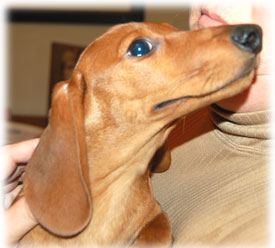 501c3 Non-Profit Org ~ Since 2011 |
Please consider making a donation, to help Husker's Hope build the funds needed to help save lives!
All photos and content
are property of
Husker's Hope
Dachshund Rescue, Inc.
Donations are processed through PayPal, a safe and secure payment center, and help cover the costs associated with the Dachshund's entrusted to our care.
There are a variety of common behaviors that require training, behavioral modification, or emotional desensitizing. All can be serious, if not addressed immediately. It is highly recommended that you begin socialization and training with your puppy or dog, as soon as you bring them home. If your dog has an extreme issue, it is best if you consult with a certified trainer or behaviorist to help you and your dog get through it. These are the most common issues we have worked with:
|
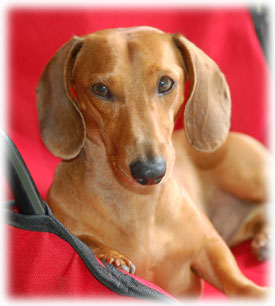 |
You may notice that the majority of behavioral problems are associated, in some way, with aggression. As a pack animal, aggression is a natural behavior in establishing pecking order, as well as, commanding or ruling their domain. It is also a sign of extreme frustration, most often associated with boredom or under-stimulation. Dogs that are left alone for long periods of time, or not given structured stimulation from their leader, will often show some signs of aggressive behavior, such as barking or lunging. One simple solution, in addition to specific behavioral modification tools, is to take them for regular walks or exercise routines that help them expel energy. It's a known fact that a dog that is less energized is more likely to pay attention; and less likely to seek attention through undesired behaviors. |
|
Dogs are pack animals, that thrive and need the companionship of other members. This is the primary reason that they make wonderful companions, and they like and need to be with their perceived pack. This can also cause issues for them, when they feel that they are separated from the pack (you) or not getting enough attention; Or, when they don't have a pack leader (you) that is willing to lead them. |
|
Anxiety stems from two potential areas; Boredom or Separation Anxiety. Boredom: If the dog is doing unusual behavior while you're at home, maybe even in the next room, most likely they are under stimulated, seeking attention. Common issues related to boredom can be, chewing, barking, potty in the house, or just getting into things they're not suppose to, in attempts to get your attention. In this case, you need to add more activity to your dog's time with you. Take them for a walk, play fetch or their favorite game, and teach them an appropriate command to trigger a proper cue from them, that it's time to do or be somewhere. In that, pay attention to their cues, as they are trying to tell you that they want something, and you need to address it. |
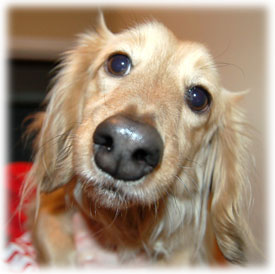 |
Separation Anxiety: If, however, your dog follows you from room to room, is extremely distress when they cannot get to you, needing to touch you often, then most likely they are suffering from separation anxiety. In extreme cases, they may exhibit destructive behaviors, to include chewing on doors or objects, in an attempt to escape; they may even jump out or through windows, chase shadows or reflections, or chew on themselves in an attempt to resolve their anxiety. In these cases, it is extremely important that you work to desensitize their extreme fear of being left alone. It's less likely that a puppy will show signs of severe separation anxiety, unless they've been in a situation that was already fearful, like a puppy mill or abusive owner, and are now with you. It is very important that you acknowledge that their fear is real and work to help them resolve it. Be patient, be kind, and be consistent. |
|
The remedy for Anxiety requires a level of time, commensurate to your dog's level of boredom or fear. In either case, it takes times, patience and consistence in addressing their anxiety. The key is recognizing that your dog is acting out, in an attempt to reach out, seeking your help in resolving what they want. |
|
|
Aggression can be linked to a specific object or situation which results in unwanted behaviors, like kennel, fence, leash, food or toy aggressions. These are correctable behaviors, through training. There is a distinct difference between these behaviors and True Aggression, which is a behavior linked to an extreme emotional issue. Dogs that come from an abusive situation, have never been socialized from puppy-hood, or have been traumatized in their previous history, may actually pose a potential threat of harm, not only to you, but also to children, strangers and other dogs. This level of aggression is very serious, is highly unpredictable in what triggers it, and requires the help of a trained behaviorist. |
|
Puppies are adorable when they play, and we laugh when those sharp little teeth are shown, as they jockey for dominance with other dogs, or even when playing with their owners. STOP THIS BEHAVIOR immediately, or it can lead to major problems when that cute little puppy, defending itself, becomes a dog that thinks they are invincible. Puppies that area allowed to play too rough need you to intervene when that play involves teeth and aggressive behavior. To ignore this, gives your puppy a false sense of justice, for the victor; and a increased sense of fear, to the loser. And, when your untrained puppy, gets older, and out of the blue, attacks another dog or person, it's not their fault, it is YOUR fault. An ounce of prevention is worth a pound of cure! |
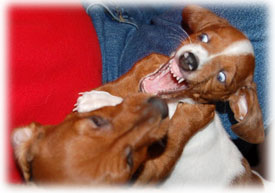 |
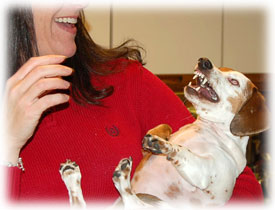 |
NEVER, under any circumstances, use commands like 'GET EM' or any positive reinforcement for aggressive behavior, no matter how cute you think it is. Teasing to promote this reaction is also wrong. If you expect your dog to behave correctly, you need to also behave correctly. This type of disregard toward a dog's behavioral needs can be directly linked to 10s of 1,000s of dogs PTS for aggression, or labeled as a "dangerous dog"; all because of the irresponsible behaviors of their owners. |
Kennel aggression can be seen, most often, with dogs that are immersed into confined situations that they do not understand. Shelter workers commonly see this type of aggression, as some breeds, especially dachshunds, do not do well in confinement situations. Often, these dogs have never known such an environment, finding the loudness of all the other animals, barking for attention, just as frightening as the 4th of July, or thunderstorms. Unfortunately, with space so limited in government run shelters, dogs that exhibit kennel aggression tend to be the first ones to be PTS, as they do not show well, and tend to nip or bite anyone that attempts to be near them, making them un-adoptable. If they're lucky, and have a shelter staff that understands this, a breed-specific rescue will be called to intervene. However, unless the rescue is equipped to deal with the potential aggression being more than just kennel related, the dog has no hope. |
|
In contrast to the obvious kennel aggression seen in shelters, many times a dog will find the home style kennel a place of safety. If the dog feels that this is the only safe place to be, they may well show aggression when you try removing them from it, or if you come near it. To them, that is their territory, be it small, and you appear to be a threat to the security they've applied to that kennel. Often, a dog that has been displaced, or one that has already been in a shelter situation, may have been conditioned by the reactions to their snapping, growling and aggressive warnings' effectiveness, that now they may be even more animated in their aggression while in an even smaller space. |
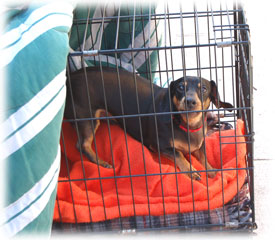 |
Unless you have experience in dealing with aggression, do NOT attempt to remove an aggressive dog from a kennel or crate. Leave the door open, allowing them to come out when they feel it's safe to do so. If your dog shows aggression while in their kennel, do not allow anyone, especially children, to put their fingers in the kennel. A dog that is showing signs of aggression is more likely to bite, even if they are the sweetest dog beyond the gates of their small domain. You can desensitize your dog's emotional connection to the kennel, but we recommend that you enlist the help of a professional dog trainer or behaviorist in doing so. |
|
Fence Aggression is when a dog has reached a point of frustration, that they bark, growl or present a stance of potentially attacking anyone or anything that is beyond the fence. For barking, visit our barking page for some tips to handle a the barking dog. Here, we're going to address those dogs with aggressive issues, relative to the confinements of a fence or perceived barrier. |
|
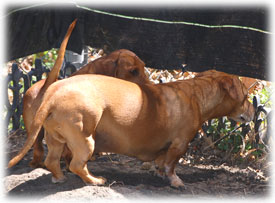 |
Often times, a dog that is left to wander the fenced yard or dog run for great periods of time, becomes bored. So, to relieve the boredom they may run the fence line, or peer beneath the barrier to see if they can see anything or anyone. It's a form of self-entertainment. The longer they are alone, the more practice they get in developing, solidifying, and protecting their perceived domain. In this case, yelling "no" or other commands for getting them to stop, do absolutely nothing in getting them to stop. If there is another animal or person beyond their fence during this time, and it's a regular occurrence, the more they bark without it affecting the movements of what they see, the more frustrated they can become. |
If you have more than one dog, engaging in the same activity, this can add more to the potential problems that occur within the fenced form of barrier frustration. In a pack situation, there is usually a level of dominance established, where one dog is the top dog. They are the absolute guardians in all things pack related. When it comes to guarding the fence, or running the fence-line, we've seen one dog attack the other dog, especially if they are intruding on their sense of "owning" that fence, and all things near and beyond, that need to be reckoned with, with a bark or fence lunge. Your dog may even attempt to dig under the fence, in an attempt to get to a rabbit, squirrel or other animals. If they succeed, you now have another problem, as they have learned how to escape. If your dog is showing signs of aggression on the fence, with hackles up (fur on the back), body very rigid, digging or lunging at the fence, and they do not respond to commands they've been trained to react to or stop with; or, if your multiple dogs engage in this activity and it turns into a fight, DO NOT ATTEMPT to physically intervene. You could get hurt. If you have a hose handy, turn it on them, to interrupt. If successful and they separate on their own, confine them. Then, do not allow them access to the yard or fence without supervision, and work on reclaiming the fence and yard with assisted training from a trained dog trainer of behaviorist. To prevent this type of aggression, start training your dog the day you get them home in yard/fence etiquette. And, never leave your dog unattended for great periods of time. In most cases, the problems of aggression are being demonstrated in other areas, as well. The most obvious need for a dog that is showing signs of fence aggression is, supervised activity to address the boredom; and, command training to address the unacceptable behavior of barking, fence lunging, or digging. Engage your dog with daily activities that do not involve the fence. Take them for walks, socialize them often, and if they must be left alone for long periods, kennel train them, hire a sitter or dog walker, and try taking them to a dog day care facility to break up the routine. |
|
Food aggression is not to be confused with food hoarding, although the two go hand-in-hand. The difference is that with food hoarding the dog vacuum eats their food. With food aggression, the dog is protecting their food, whether they want to eat it or not. They may even prevent other dogs in the home from eating their food. Food, in their mind, belongs to them, and only them. In both cases, the lack of food in their history, is the culprit for their need to feed fast or protect their food. Emaciated dogs tend to vacuum feed, as they have been conditioned that food is scarce and they must eat as much as they can, as they do not know when or if more will be available. |
|
In either case, your dog has an issue with food that needs to be addressed. For the food hoarder, that vacuums their food, this can pose a problem for their digestive tract. When gulping, they also take in a great deal of air, which can cause stomach upset, or even stomach bloat (a serious medical condition that can prove fatal). Consider purchasing a "slow feeder" bowl, as pictured, that is designed to prevent a dog from eating too much, too fast. Most Pet Supply stores carry them, but you can also find them online, if the size that you need, is not available. The key in size, is that your dog should not be able to get more than their snout in any given area. If they are able to move around in an are, the bowl is too big. If they cannot get to the food, the bowl is too small. You can also improvise by putting a heavy rock or barrier object in the bowl. But, we've found that the dachshund can easily move those around. After all, they were bred to use their snout for hunting activities, and the barrier object will be easily moved or removed, at their whim. |
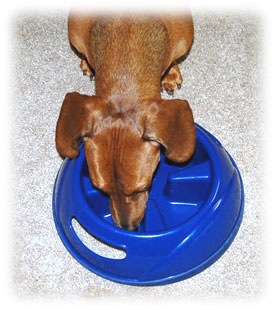 |
|
With food aggression, it is your job to teach your dog that they do not own the food. Food should be something that addresses their need to sustain life, not induce rage. Often times food aggression evolves from the dog not getting enough to eat. Whether they were nudged too often by a rival nipple feeder on mom, or come from a situation where the food was rare, as in puppy mills or other instances of neglect. You can start working with your food aggressive dog by feeding them separate from other dogs, be it in another room, or in a kennel. This will give them a sense of security and remove the threat of their food being taken by others, or vice verse. In the process, you need to address their aggression by desensitizing them from the need to protect their food or take the food from others. This takes more time, but can be effective, in the long run, in resolving their food aggression. Another method is to restrict your dog's intake by only giving them a few pieces at a time. Increase the amount when the dog lessens their intensity in feeding. Wait 30 seconds or more before giving them more. While your dog is learning to control their aggression with food, you should never allow them free feeding. They need to be on a consistent, regular feeding schedule. Knowing that the food is coming everyday, at a specific time, in a specific place, and on time, helps the dog resolve their fear of not having food, and their need to protect that food when it's available. If you have other dogs, it helps a great deal to teach them "leave it" when approaching the aggressive dog's food. This not only helps them all stick to their own bowl, it goes a long way in reassuring the food aggressor. Dogs, especially dachshunds, have a keen sense of "fair play" and "pecking order" and by asserting your control over who eats what, how much and when, you have a greater impact on preventing and addressing issues that can arise during feeding time with your dog(s). |
|
If you've never trained your dog to walk properly on a leash, visit our commands page and get some tips in leash training. Leash aggression stems from a dog that has never been properly trained, or a dog that has other aggression issues, that are exacerbated at the end of a leash, such as fence, territory or object aggression. To allow your dog to continue showing aggression at the end of a leash, without addressing the underlying issue, can lead to more serious issues, as well as harm to other dogs, children or strangers, when encountered in a public setting, be it a park or the sidewalk. |
|
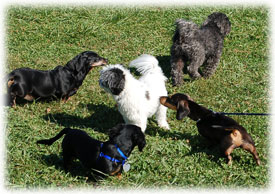 |
Similar to fence aggression or territorial aggression, an untrained dog at the end of a leash, that lunges, barks and fights to get to the object of their aggression, stems from a lack of training. The leash aggressive dog is the one dog that strains and pulls, no matter how hard you struggle to restrain them, trying to get at another dog. Let them get close enough and they will snap or even bite the intended object of their aggression. If leash aggression is not addressed, it can turn into True Aggression, which is an emotional dysfunction. The majority of leash aggressive dogs lack socialization, and do not realize that the world is not their domain. It's up to you to set the boundaries. |
Train your dog, as soon as you get them, the proper behavior at the end of a leash BEFORE you venture out to the dog park, or any public setting. Keep in mind that a leash is NOT a natural part of the dog's innate understanding. To them, it is a barrier to their freedom and poses a great frustration when they cannot get to what they want. For those dogs struggling with other aggression issues, it would not hurt to invest in a soft muzzle, to protect the people and dogs your might encounter, until you have complete control over your dog, working on issues of aggression. |
|
Toy or Object Aggression is when a dog will not allow you, or another dog, to play with or remove a toy or object from their possession. This also includes when they refuse to stop looking for the object, when removed. This can be a mild possessiveness, if they simply make complaints or play keep-away with other dogs. It becomes Aggression, and serious, if they growl, show their teeth or snap (or bite) when you come near or try to remove the object. Sometimes, just being in the same room as their prized object is enough to cause aggressive behaviors. |
|
In mild cases, you can incorporate the "leave it" command as you are work the command training with your dog. If they've mastered that command, they are less likely to fight you for possession of their toy or other objects. With these, you can negotiate their attention, by offering them something else to do; take a walk, play fetch, or use the toy to work on some of the basic commands. Just like humans, dogs have a sense of "ownership" when it comes to things they really like. Toys, bones, balls, you name it. If it's perceived as belonging to them, they have the natural tendency to not want to share it with others. It becomes hoarding, when the remove these objects, hiding them in piles in or under furniture. |
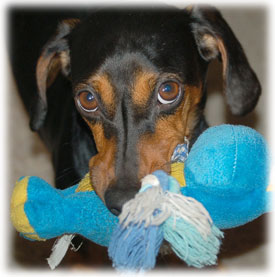 |
Select a specific spot or basket to be their toy box. Teach them to put their toys back, or get them. But, also teach them to "leave it" until the proper time, that you designate. It then becomes another boundary that you establish with them. If your dog shows signs of aggression with objects, remove those objects from the room, and place them in a location that they do not have access or view of. Engage them in another activity. In a few hours or days, bring the object out; if they show aggression, remove the object. This is something that will take many times, and possible many different objects, but eventually they will begin to realize that YOU own the item, and they must negotiate, with the proper attitude and behavior, to have access to it. As with any training, especially when working with extreme levels, it is extremely important that you remain calm, assertive, and consistent when dealing with each issue. |
|
|
Possession is a tricky one. This is an area that evolves around all others, as possession is any time a dog exhibits behaviors of ownership. All dogs have an innate desire to protect what is theirs, be it their domain, food, toys, or territory. Being this way is normal. Being overtly aggressive in this can be dangerous to you, other dogs, your family and friends. While it's okay for your dog to want to put his toy somewhere others cannot get to it, it is NOT okay to attack anyone that comes near it, a hiding spot, or someone that may have possession of their item. |
|
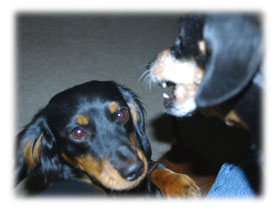 |
Typically, this behavior is not something that occurs everywhere. Usually this is something that happens at home, where they feel comfortable and have established boundaries. A new dog may not show any level of possession, until they feel confident in the new environment actually being their home. So, use caution and be mindful of the potential, especially with a rescued dog. With new dogs, especially older dogs, one of the first things, though not an object in the normal sense of possession, that we've observed signs of aggression with, is the owner's lap. It doesn't matter if they've been there a day or months, this seems to be the first item that they feel comfortable in, and in control of, while in it. |
Keep in mind, when you adopt a new dog into your family, with existing dogs or children, that the first place they find comfort is in your arms or on your lap. In extreme cases, we observed dogs literally go into attack mode, if another dog or child approaches the lap of the person they trust enough to hold them. DO NOT put the dog down, as you would with an uninvited lap stealer, or you will risk injury to the dog or child attempting to get your attention while the dog in your lap shows it's teeth or emits a low growl. With lap aggression, you need to train the new dog immediately that the lap is OFF LIMITS unless you invite them into it. This is something that you should train all of the dogs in your house, to prevent and avoid the potential squabbles that arise from this aspect of possession aggressiveness. There is nothing more terrifying than dealing with a dog fight; it's even more terrifying to have to deal with it in your lap! |
|
|
If you have a dachshund, or have read our information about the Dachshund breed, you know that it is their nature, as with several hunting breeds, to hunt, kill and eat small animals. However, this is not limited to just those breeds that were designed to hunt. If left in the wild, most animals will hunt to survive. Cats are actually quite prolific little hunters, and to watch them stalk their prey is amazing. Bringing the lifeless body of the prize to your door-step, not so much. |
|
Typically, we see this problem more with the smooth and wire coat dachshunds, than with the long hair dachshunds. But, keep in mind, the breed, as a whole, was designed to hunt badgers and other small animals. Dachshunds are extremely intelligent, agile and fast, in their prime. The love to run and they love the thrill of the chase, more so than the end result. Which is what has made Dachshund racing go viral, around the world. The predatory instinct becomes a problem, when it kicks in with the family cat, squirrels, rabbits and running children. And, it ties in with being territorial, as well as, fence aggression, digging and escaping, in an attempt to catch their prey. |
 |
Because of this predatory instinct, dachshunds don't always make the best companions for family cat and small children. In this instance, raising them with children and cats is no guarantee that their predatory instinct will not surface. You can usually tell if a dachshund, whether young or old, will have a problem in this area, before you bring them home. If you're looking to adopt from a shelter or rescue, ask them to cat test the dog, before you bring them home. Most shelters and rescues will be more than willing to invest the time to test this for you. However, if this instinct evolves into chasing cars, rabbits or children, this is something that isn't as easy to test for. Best rule of thumb, is to begin command training as soon as you bring the dachshund puppy home. With older dogs, unless the shelter or rescue has access to their history, it is best to NOT bring an older dog into a potential situation with younger children, or cats. Sometimes, with small children, older dogs may not have a predatory instinct, but rather, a low tolerance for the untrained child. |
|
|
There is such a fine line between all the areas mention up to this point. Being Territorial is a natural aspect of every creature on the planet. We draw the lines in the sand, as humans, and will protect our property with whatever means we have. The dachshund is no different. Perceived territory is something very important to any dog. It gives them a sense of boundary from which to call their own. It is normal for a dog to exhibit signs of protecting their territory, like barking or alerting with a low growl, while laying on the couch, and something or someone new enters their world. |
|
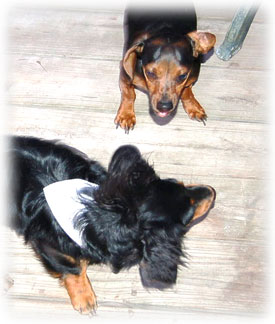 |
With the dog, a territory is any space they feel belongs to them, be it the yard, the house, a kennel or even your lap. Here, we are focusing on the instance of space. The typical response to potential intruders, is to bark. This, in itself, is the basis for the most complaints about dogs. It become a dangerous situation when it is not being addressed by the owner. A barking dog, protecting his territory, can become aggressive, unless the owner takes the time to work with their dog on this behavior. Let go and it could well turn into a situation of True aggression, where the dog lunges, escapes or causes harm to other dogs, people or even the owner. As a rescue family, we see this behavior more often than others, in both our personal dogs, that tolerate a new addition on a regular basis; and, with the foster dog, that is just trying to survive, and find a small piece of territory to call their own. |
With the proper training, a dog with a well-defined territory and command training, makes an excellent watch dog! The dachshund, in fact, is an excellent watch dog with centuries of "alerting" bred into them. Without training, however, they will alert to every sight and sound they don't understand or is new to them. Do your dog justice by socializing them often, work on training with them daily, and never assume your dachshund is perfect, even with all the best training. |
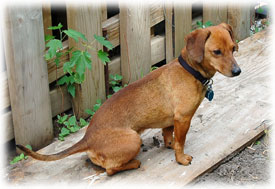 |
The dachshund is extremely intelligent, with a splash of cantankerous willfulness that will always keep you on your toes. And, the varied degrees of these elements are anything but consistent with age. The key to peace in the dachshund family, is that the you, the owner, be consistent and work with your dog on what it needs. Patience is the most valued tool of any dachshund owner. If, in any given situation, you feel that your dog and their needs are beyond your control, consult a dog trainer or behaviorist for help. Your local animal shelter is also a great source of information, in working with your dog. |
|
